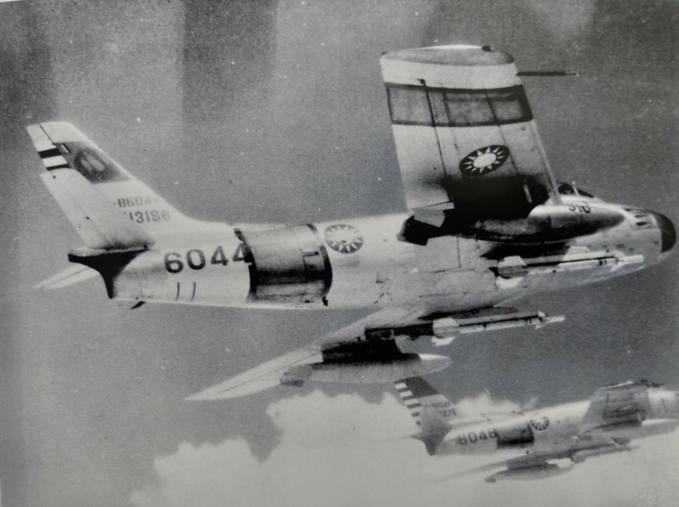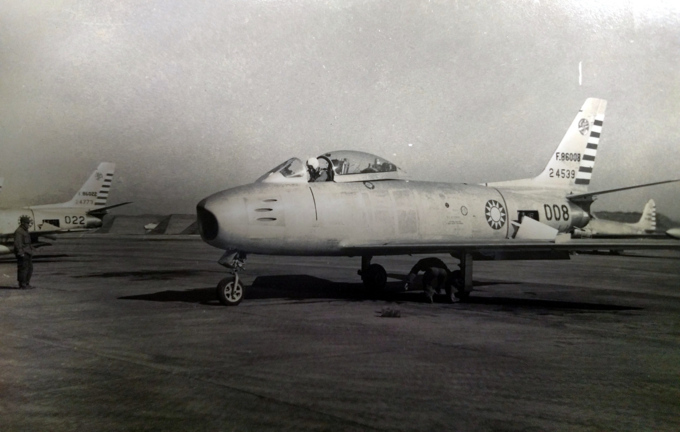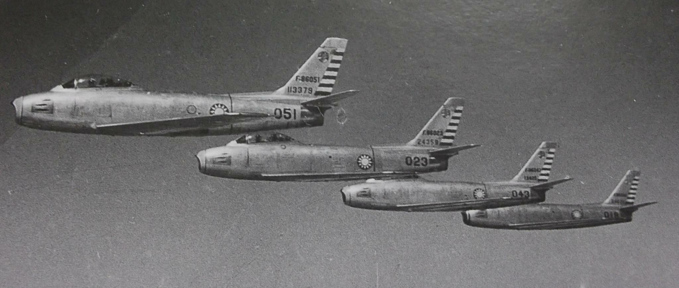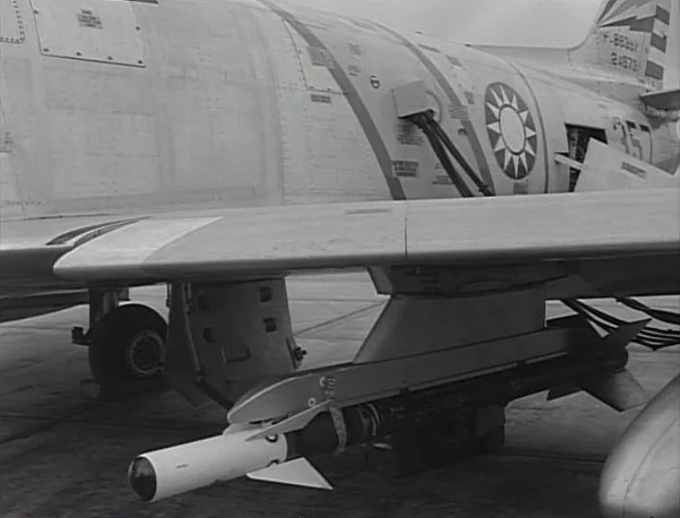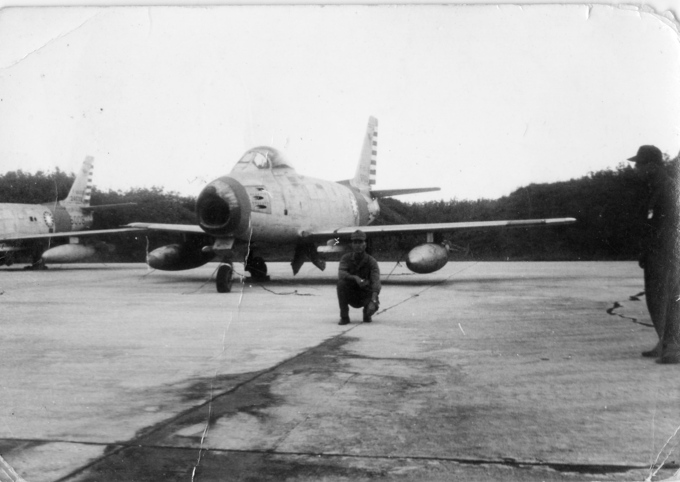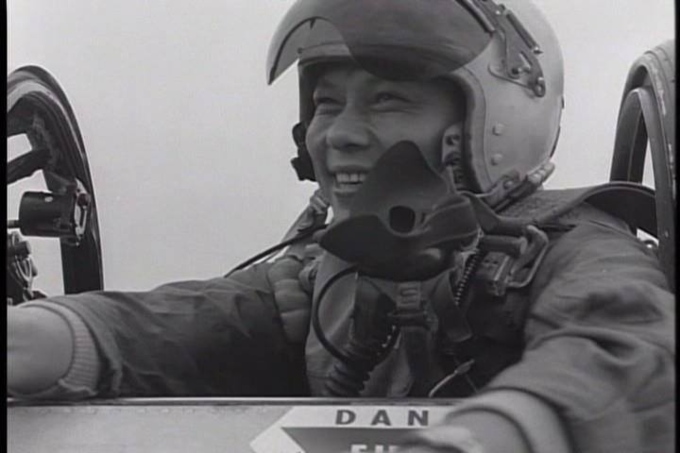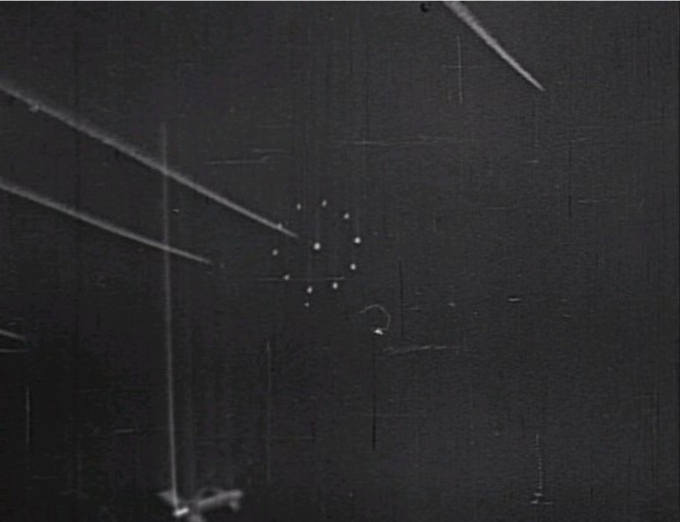The Republic of China was one of the many nations to use surplus F-86 Sabre jet-fighters. The aircraft would engage in air combat with Chinese MiGs during the Taiwan Strait Crisis of 1958. Additionally, ROCAF Sabres were among the first aircraft to be equipped with AIM-9 Sidewinder missiles, which allowed them to compete against the superior performance of the Chinese MiG-17s. However, while the AIM-9's deployment was a considerable setback for the PLAAF, the situation changed when a Chinese MiG-17 returned to base with an unexploded AIM-9B lodged in its airframe. The missile was given to Soviet technicians, and subsequently reverse-engineered into the R-3 series of missiles.
Background
In the 1950s, after the end of the Korean War, the US government decided to send more modern military equipment to Taiwan to counter the increasing threat of the mainland Chinese Army, especially the PLAAF's MiG-15 fighter, which was supplied by the Soviet Union and saw action during the Korean War.
At this time, the straight-wing F-84 Thunderjets of the ROCAF could no longer effectively counter the MiG-15 with its swept-wing design. The US government decided to supply more than 500 F-86 Sabres to Taiwan in the early 1950s.
Some sources claim this number is just an estimate, not the actual number of Sabres in the fleet, because many were delivered in the mid to late 1950s. Some sources also confirm that Taiwan received 415 F-86F fighters, 18 F-86D interceptors and 7 RF-86F reconnaissance aircraft in total).
This Military Assistance Program (MAP) was named 4F343, and started in 1954. About 320 F-86F Sabres and 7 RF-86 Sabre reconnaissance aircraft were delivered to the ROCAF. Apart from that, the ROCAF also received about 18 F-86D-36 Sabre Dog interceptors from the US Air Force in 1960.
The first Sabre delivered to the ROCAF was an F-86F-1, series number 51-2893. By June 1956, 171 F-86s had been delivered, including 38 F-86F-1s, 9 F-86F-5s, and 23 F-86F-10s. The 26th Fighter Squadron from the 5th Fighter Wing stationed at Taoyuan Air Base was the first combat unit to receive the new Sabres in late 1954.
The ROCAF also received some F-86F-30s, but it is unknown whether they received actual F-40 variants. At that time, North American Aviation not only produced the F-86F-40, but also modification kits for countries that received the F-30 variants to help them upgrade their Sabres to the newest version. One F-86F-30 captured by the PLAAF in the 1950s is displayed in the Beijing Aviation Museum and has leading-edge slats, which were re-added to the Canadian CL-13 Mk.6 and American F-86F-40s. This gives solid evidence to the theory that the ROCAF had upgraded some F-30s to the newest F-40 version.
ROCAF vs PLAAF
In the 1950s, the PLAAF often sent aircraft to the Taiwan Strait for provocations in order to intimidate Taiwan. The ROCAF showed no fear, sending fighters to intercept the intruding PLAAF aircraft. The ROCAF also sent aircraft to the mainland for reconnaissance missions as a form of counterattack. The PLAAF scrambled their new MiG-17s, MiG-17Fs, and J-5s against the ROCAF's Sabres, with the latter usually reigning victorious in air combat.
On paper, the F-86F Sabre's maximum level flight speed was less than that of the MiG-17 and MiG-17F; the latter's climb rate at sea level was also slightly higher than the F-86F's. However, the early versions of the F-86F had a maximum climb rate almost the same as or even higher than the MiG-15bis and MiG-17s. The Sabres could also out-turn MiG-15s and MiG-17s in both instantaneous and sustained turn fights. Apart from that, the F-86Fs had an A-4 gun/rocket/bomb calculating gunsight which worked with the AN/APG-30 ranging radar, which were more advanced than the avionics equipped on the PLAAF's MiGs (note that the J-5 did not have the ranging radar mounted on the later versions of MiG-17F).
From a training point of view, the PLAAF's pilots usually lacked the necessary combat experience compared to ROCAF pilots at the time, which was a glaring issue during the Matsu air battle on July 21, 1956. ROCAF pilots even shot down several PLAAF MiG fighters with older F-84s loaded with HVAR rockets and at a numerical disadvantage.
AIM-9B "Black Magic"
On August 18th, 1958, under the secret project "Black Magic" (codenamed "明星計劃" in Chinese, Operation Bright Star), a C-124 transport plane landed in Taiwan with some American technical officers and the new GAR-8 Sidewinder infrared-guided air-to-air missile, better known as the AIM-9B. To teach ROCAF pilots how to operate the new Sidewinder missiles, US pilots flew F-100 Super Sabres to simulate PLAAF MiGs, while ROCAF pilots flew F-86s to conduct simulated attacks on the F-100s with their Sidewinder missiles. During this, technical officers collected data of the Sidewinder missiles in combat to find flaws and areas for improvement.
On July 29th, 1958, a PLAAF MiG-17 shot down a ROCAF F-84G and heavily damaged another (the pilot successfully bailed out in Magong). A few weeks later, ROCAF F-86s shot down four MiG-17s. At that time, the ROCAF had received 40 Sidewinders and 40 launchers in total. On September 10th, 1958, two batches of ROCAF pilots returned to their squadrons after completing training on using the Sidewinder missile.
Sidewinder Debut over the Taiwan Strait
On September 24th, 1958, the ROCAF sent nine RF-84F Thunderflash reconnaissance aircraft to the mainland for a surveillance mission. The commander saw it as an opportunity to test the combat effectiveness of the new Sidewinder missiles, so the 11th Fighter Group was ordered to undertake an escort mission for the RF-84s. The initial plan was that the Sabres would be divided into four squadrons: the first squadron had four Sabres equipped with Sidewinders, while two more squadrons without missiles were to assist the missile-equipped squadron if they encountered trouble with PLAAF MiGs in close-range battle.
The fourth squadron was ordered to stay at 45,000 feet to act as a decoy, using the condensation trail of the J47 engine at high altitude to attract the attention of the PLAAF MiGs, so that the other squadrons could attack them while they were climbing.
At 10:30 am, the attack group led by Lieutenant Colonel Li Shuyuan arrived in the sky over Wenzhou. One minute later, a message came from Shimen Battle Control Center reporting that PLAAF MiG fighters were taking off from Luqiao Airport to intercept the ROCAF reconnaissance aircraft. As originally planned, the MiGs' attention was drawn to the Sabres at high altitude. Unfortunately, the first squadron couldn't identify whether the condensation trails was friendly or foe, so Lieutenant Colonel Li Shuyuan ordered the Sabres of the fourth decoy squadron to bank right, which allowed him to identify them.
At the beginning of the battle, Li Shuyuan and Qian Yiqiang each fired one Sidewinder and shot down one MiG-17. One MiG-17 managed to evade a Sidewinder fired by Qian Yiqiang, but was hit by another missile fired by another Sabre. The last MiG-17 was shot down by another missile fired by the fourth F-86F Sabre fighter of the first squadron. After suffering severe losses, the remaining MiG-17s decided to withdraw from the battle.
Later, four Sabres from the commander squadron ambushed a MiG-17 formation which had just taken off from the airfield and successfully shot down one. After that, the fourth squadron scored two more kills, and another squadron led by Ma Dapeng successfully shot down another two.
The ROCAF's F-86s had successfully shot down a total of nine PLAAF MiG-17s, four of which were Sidewinder kills and the remaining five by gun.
From the PLAAF's point of view: At 8:47 am, twelve J-5/MiG-17s from the 46th Regiment of the 16th Division took off to intercept eight Sabres. At 9:06 am, eight MiG-15bis from the 5th Regiment and eight MiG-17Fs from the 6th Regiment of the 2nd Division spotted four Sabres flying at 13,000 m at 9:30 am. The enemy then tried to turn to avoid engagement (which was the same as the description of ROCAF's combat report, but one hour earlier). The commander of the 2nd division ordered the formation of the 5th Regiment to pull back in order to attract the enemy aircraft to the mainland, but when they tried to bank right at Wenzhou Bay, the fourth plane suddenly lost control and began to dive steeply. Others saw this and told the pilot to bail out, but there was no response received. In general, the PLAAF claimed that they only lost one fighter due to a Sidewinder.
The F-86F Sabre remained in ROCAF service until 1977 and was retired when its flight performance and endurance were considered outdated and unsuitable for active service. It was replaced by the more advanced F-100A Super Sabre and F-5A Freedom Fighter.
